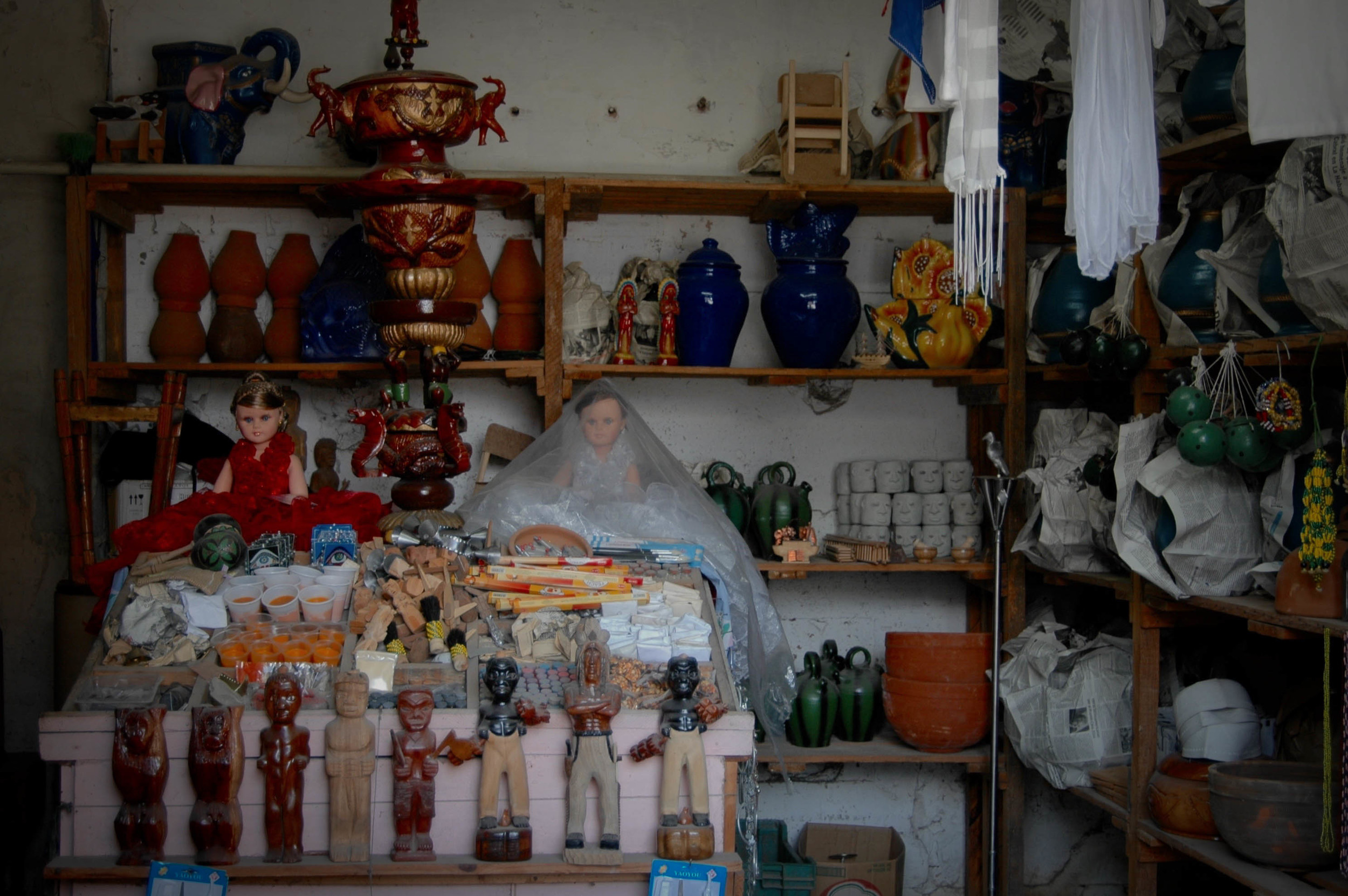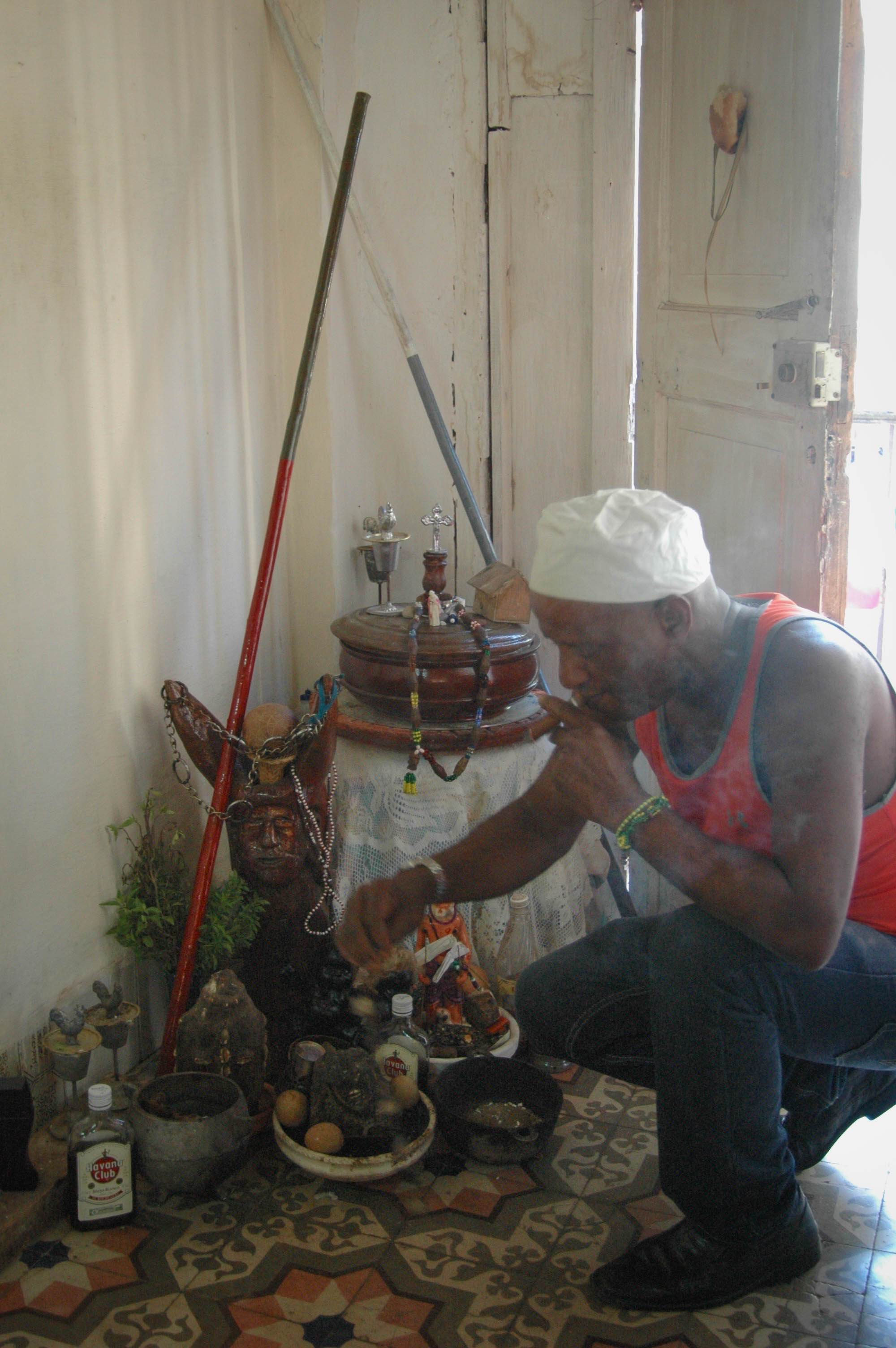Santería, Blessing or Curse?
I was in Cuba for a whole of two weeks with nothing more than a mere sighting of a wand that I could only assume was a ceremonial tool for Santería. I quickly scanned the room in the hostel-like home I was hoping to find other items to strike up a conversation on the subject, but no luck. All I saw was this cowry shell and feather wand in this "casa particular."
Then on my final day, after pushing my disappointment aside, I stumbled upon it. Actually, I'm not sure whether I found it, or it found me... but it was real and authentic nonetheless.
There I was, at a table in a tiny apartment-like home next to a man wearing a white ceremonial hat. He was smoking a cigar and talking quietly under his breath while stuffing the innards of a fish, gold, and other mysterious items into a small souvenir that I was instructed to take with me. This wasn't witchcraft or magic, though my fascination as an adolescent did have me concocting recipes make-believing they were cures or potions of some sort. I should've paid closer attention as it may have propelled me in the direction of natural healing a little sooner. Naturally, I was drawn to witchcraft. It wasn't the "dark" or "magical" thoughts we conjure up with the mere mention of the word "witch," but for the healing aspects. A witch's connection to the earth and universe is something I've always looked up to and tried further to invoke in myself. But this post is not about witchcraft. It's about the mysterious and often ridiculed religious practice that has swept over Cuba, and it's called Santería.
Santería (way of the saints) or Rela de Ocha or Lucmi is a religious practice rooted in the Yoruba religion from Western Africa. Starting in the 1500s and lasting through the 20th century, the slave population in Cuba reached 400,000, and naturally, the Yoruba religion came with it. The Catholics tried to convert the African slaves from their practices without success. To preserve their beliefs, the slaves disguised their worshipping by combining them with those of Christianity and practiced in hiding. Ceremonies were done in the Santero's ilé or temple-house, which is still very much the case. Now, it is said, that as many as 80% of Cubans observe some form of Santería.
When a Santero or Santera is initiated into the religion, they ceremoniously speak directly with the Orishás, or guardians, using tools such as cowry shells or dilgún, coconut or obí, and divining chains called epuele. They are also given an Eleggua statue made of clay which utilizes cowry shells to form a face for the Orishá Eleggua. He is key to any religious practice as his blessing is necessary to carry out the protection or request.
On my final full day in Havana Vieja, I came across a store full of trinkets that absolutely had to be used in ceremonies. My initial response was to walk up slowly as not to alarm the man working in the store causing him to think that I was disrespectful in any way. After a few moments he called me over, and I asked him if it was indeed a store carrying items for ceremonies, and he acknowledged it. He showed me a book on Cuban Santería and gifted me a small yellow and green beaded bracelet to wear for protection.
As I walked away, I realized this bracelet was not blessed and given any specific intention for me. Coincidentally, as that occurred to me, I ran into two older men in the street and noticed one was wearing the jewelry of a Santero.
These are two of the kindest men I have ever met. Just two strangers in the street, yet they were so genuine. My Santero is on the right looking like a regular Joe, while his friend on the left..well you can just see the kindness in this man's face. He got goosebumps several times during our conversation and couldn't stress enough how I am a Cuban girl and not to ever let anyone tell me otherwise because I have it in my blood.
I introduced myself to these gentlemen and informed them of my concern about the bracelet I had just been given. I inquired about my accepting the "pulsa" without a proper blessing, and the Santero seemed a little concerned but said he could help.
He took a small rock out of his pocket and lightly rubbed it over the top of the bracelet and then told me to flip my hand over so he could get the bottom portion. When he started on the other side, the rock slipped from his hand, and I quickly caught it before it fell to the ground. Immediately, both the men reacted, and the Santero jumped back and showed me the goosebumps forming up and down his arms. When I went to hand him the rock, he stepped away shaking his head with his arms in the air and wouldn't touch it. He said that it was now mine.
I was very confused so asked why they reacted the way they did, was it a bad omen? They told me it was really good because I managed to catch it. If it would've fallen to the ground, it would've been bad for me. They were blown away that I caught it and said I have excellent luck. We chatted for a bit more where they learned of my Cuban roots but were quite bothered that I wasn't married. In fact, so genuinely concerned that the friend of the Santero told him he had to help me. Next thing I knew Jesus, the religious of the two, ran off to a store to purchase a ceremonial tool for me.
Just a few moments later we were on the way to his home in a nearby dilapidated building where we climbed several flights of stairs dodging large holes in the, once elegant, marble flooring. I know you're probably a little concerned that I trusted this character whom I'd just met on the street and was now following home where he practices Santería, which at times involves animal sacrifices, but trust me when I say he is a good guy and even invited one of his female neighbors so that I would feel comfortable. Once inside his modest home, I met his mother. He also went as far as to call his girlfriend so I could meet her over the phone since she couldn't be there in person. I was now part of the extended family. Oh, and how could I not trust a man named Jesus!
The ceremony started out with some questions while Jesus used his epuele to decipher the answers from the Oríshas. He kept saying over and over how I have luck on my side and he's thrilled to help me. He pulled out the small black and red figurine-like item he purchased at the store and started carving into it. He was making a face. Then in the center of this little item, he sprinkled some stuff that appeared to be herbs, a powder substance, clay from the pot where he kept his Eleggua statue, the innards of a small dead fish, a nail, some corn and gold from a capped tooth. I wasn't clear whether the gold was from one of his teeth or from someone else. I was just grateful that he wanted to put an end to my solo streak and ongoing "non-relationships" which is the best way to characterize my past. There was some cigar smoke blowing, and a lot of chanting during the ceremony which lasted a little over an hour. Before I left Jesus made us some Cuban coffee, and we sipped before I headed out.
I was a little worried that this ceremony would end up costing me a pretty penny but how could I not accept the offer? As it turned out Jesus only wanted to help and wouldn't accept payment. He sent me away with the small totem and instructions to give it some rum, honey and cigar smoke as an offering every once in a while.
Jesus posed for a few pictures in front of his offering area by the door. I will never forget his face and his kind attempt at helping me to find a suitable partner. You see, there are good people in this world who do things out of the purity of their hearts. There was no obligation for him to help me. He even came out of pocket in doing so with the purchase of the totem, the gold cap and all the other things he managed to stuff inside that small piece of plaster that now resembles a face. He and his friend were pure joy.
There are good people all around us. We have the power to choose whether we focus on the positive or the negative, and I chose to surround myself with and focus on the good!
We'll see what happens with this new blessing I received...




















